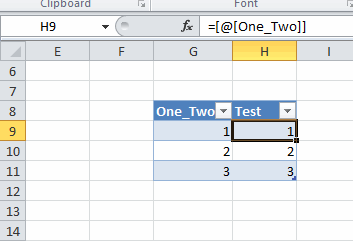If you use certain characters in the column names of your table, then you have to use double brackets around those names when you refer to them in formulas. I don’t care for that, so I don’t use those characters. I was converting some imported data into a table and, of course, it had spaces in the column names (and a few other naughty characters). I needed to clean up those characters before converting to a table. The formula below shows what the double brackets look like.

This office web page provides a list of characters that cause this behavior. I don’t know where they got that list, but I did notice that there was no underscore on it. I like to use underscores to separate words, but I can’t use them in tables because of the double bracket thing. I figured I’d better make my own list if I’m going to clean up data.
I wrote this code to list out all of the bad characters:
|
1 2 3 4 5 6 7 8 9 10 11 12 |
Public Sub TestColHeaders() Dim i As Long For i = 1 To 255 Range("G8").Value = "One" & Chr$(i) & "Two" If Left(Range("h9").Formula, 4) = "=[@[" Or InStr(1, Range("h9").Formula, "'") > 0 Then Debug.Print i, Range("h9").Formula End If Next i End Sub |
It loops through all the characters in the basic ASCII character set, inserts the character into a the column header, and reads the formula that references that column. I check for
|
1 |
=[@[ |
or an apostrophe. It turns out that all the characters you have to escape with an apostrophe also cause double brackets, so I only needed to check for the double brackets.

With my list, I created a function to clean the data before I use it as a column header. I don’t check for Chr(13) because I don’t think you can have that in a cell.
|
1 2 3 4 5 6 7 8 9 10 11 12 13 14 15 16 17 18 19 20 21 22 23 24 25 26 27 28 |
Public Function CleanTableColumnHeader(ByVal sHeader As String) As String Dim i As Long Dim sReturn As String sReturn = sHeader For i = 32 To 47 sReturn = Replace$(sReturn, Chr$(i), vbNullString) Next i For i = 58 To 64 sReturn = Replace$(sReturn, Chr$(i), vbNullString) Next i For i = 91 To 96 sReturn = Replace$(sReturn, Chr$(i), vbNullString) Next i sReturn = Replace$(sReturn, Chr$(123), vbNullString) sReturn = Replace$(sReturn, Chr$(125), vbNullString) sReturn = Replace$(sReturn, Chr$(126), vbNullString) sReturn = Replace$(sReturn, Chr$(9), vbNullString) sReturn = Replace$(sReturn, Chr$(10), vbNullString) CleanTableColumnHeader = sReturn End Function |
Now, to make sure my Excel workbooks are utterly un-editable by anyone else, I’m going to write an event handler that converts all my underscores to something else as I type them. The only question, is should I use an elipsis (chr$(133))
|
1 |
One…Two |
or a macron (chr$(175))
|
1 |
One¯Two |
That’s a tough one.
In similar cases I use Chr$(160). It looks like a space but is not space
Hi Dick – You can have a chr(13) is a cell. It’s what XL puts there when we do an alt+enter, or one could concatenate it in with CHAR(13).
If you switch to chrW() you have all of unicode at your disposal. Think of spreadsheets with chrW(10086): ❶. Or not.
…mrt©¿©¬
Hmm. Forgot the semicolon. chrW(10086) is ❶
No, it’s not. It’s a floral heart: ❦
It only puts the double brackets in when you’re using the @ i.e. ThisRow referencing, doesn’t it? I don’t see why that’s an issue…I never type those double brackets because Excel does it for me when I use the mouse to click on the cell I want in my partially completed formula. But then I know how much you hate the mouse…
I’m pretty sure Alt+Enter is Chr(10), not 13.
Very often I’ll type INDEX MATCH or SUMPRODUCT formulas against a table on another sheet and don’t point to references. I can still point to references with the just the keyboards, but it’s easy to type with autocomplete.
Dick – it is. I checked and I should have checked better. It’s OS dependent, and I checked on the, ahem, less popular OS.